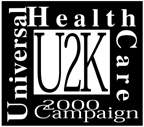Intro | Private Ins. | Medicare | Medicaid | Managed Care | Crisis | Reform

|
Data on the Health Care Crisis in the United States |
America's health care costs too much, covers too little, and excludes too many.
The market -based system of the 1990s is failing to solve these problems. It is time for change.
This section of the U2K Education Handbook provides data and expert opinion on these issues.
America's Health Care Costs Too Much
Health care in the United States has cost more than in other industrialized nations since World War II. In the 1990s, market forces were supposed to control costs, yet health expenditures are still rising faster here than in comparable nations.Percent of Gross Domestic Product (GDP) spent on health:
| 1960 | 1990 | 1997 | |
| United States | 5.2% | 12.6% | 13.5% |
| OECD* mean | 3.8% | 7.2% | 7.5% |
| Ratio: U.S/OECD | 1.37 | 1.75 | 1.8 |
Why does health care in the United States cost so much? There is no one single cause. Most academics will agree that the following list includes all the major causes, though they will differ on the relative importance of each.
1. A style of medical practice more technology intensive than in other nations. The United States has more than three times the number of CT scanners and five times the number of MRI units per million population than the average of other industrialized nations. This technology-intensive style is particularly striking in hospital care. In 1996, the average cost per day in American hospital was $1,128; Denmark was next at $632 per day, followed by Canada at $489 per day. The other twenty countries spent less than $350 per day.
2. Higher prices for the same goods and services. Recently attention in this area has focused especially on pharmaceuticals. U.S. consumers usually pay 25% to 100% more than customers elsewhere for medications produced by the same multinational pharmaceutical companies. Coronary artery "stents", a brand new medical device to prevent heart attacks, cost $500 per stent more in the United States than in Canada.
3. Administrative waste. Approximately 25% of the cost of health care is spent on nonclinical administration related to insurance eligibility determinations, billing procedures, and marketing expenses. Other industrialized nations spend half this amount.
America's Health Care Covers too Little
Approximately $1 out of every $6 spent for health care in the United States comes directly out of patients' pockets for individual products and services. In some instances, this money is a co-payment and insurance pays the rest. In other instances, the out-of-pocket payment is the full payment because the patient has no insurance or insurance does not cover the service.
These burdens are the highest on the sickest people.
Out-of-pocket spending on health care, 1996:
| By the average person: | $470 |
| By the sickest 10%: | $1864 |
| By the sickest !0% without insurance: | $1966 |
Managed care tends to be not so much about managing care as about managing costs. Companies manage costs by making it harder for patients to receive recommended procedures and services, either by placing administrative barriers to physicians ordering them or by making patients pay more for them. The backlash to these practices has been the motive force behind the legislative activities at the state and national level to regulate managed care and protect patients.
America's Health Care Excludes too Many
How Big is the Problem?The percentage of the non-elderly who are uninsured is increasing every year, despite a strong economy for the past eight years:
Percentage of the non-elderly without health insurance:
| 1988 | 15.5% |
| 1990 | 16.1% |
| 1992 | 17.0% |
| 1994 | 17.1% |
| 1996 | 17.7% |
In March 1998, 44.3 million Americans were without health insurance.
These numbers underestimate the problem. 1997 data show that over a two year period, one-third of nonelderly adults had a gap of one or more months in their health coverage.
Who is affected?
Lack of insurance is mostly a problem for low-income workers. The majority of Americans who lack health insurance are white, but the risk of uninsurance is about twice as high for African-Americans and Hispanics than for whites. Seventy-two percent of uninsured workers earn less than $20,000 annually.Income and the Risk of Being Uninsured, 1995:
| <100% of poverty | 23% |
| 100-199% | 27% |
| 200-299% | 18% |
| 300-399% | 11% |
| >400% | 7% |
Family Work Status of the Uninsured, 1995:
| One full-time worker | 50% |
| Two or more full-time workers | 29% |
| Only part-time workers | 11% |
| No workers | 10% |
How does not being insured hurt?
People without health insurance do receive some health care, but it is often too little and too late. Sometimes the neglect of chronic conditions in their early state leads to more expensive care later on.The uninsured are three times as likely to lack a usual source of care than insured.
The uninsured are twice as likely to have not seen a doctor even once in a year.
The uninsured are only two-thirds as likely as the insured to receive preventive examinations such as mammograms, pap smears, prostate exams and physical exams.
Compared with the insured, the uninsured are four times more likely:
- to not get needed medical care.
- to postpone care due to costs.
- to not fill a prescription.
The uninsured are hospitalized at least 50% more for „avoidable hospital conditions‰ such as pneumonia and uncontrolled diabetes than the insured.
Children without insurance are nearly twice as likely not to receive medical care for acute conditions such as asthma and ear infections.
When breast cancer is diagnosed, nearly twice as many uninsured women have advanced disease than insured women.